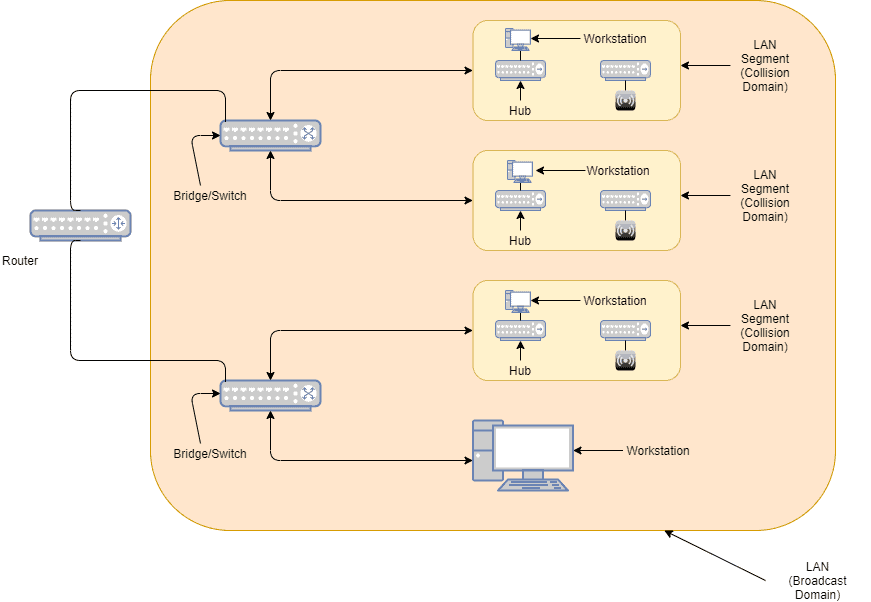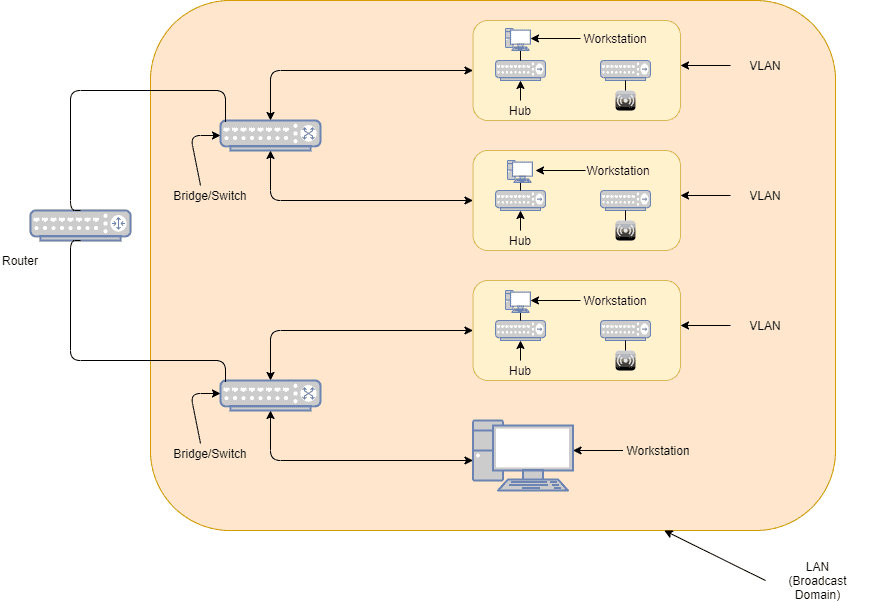1. 概述
VLAN(Virtual Local Area Network,虚拟局域网)是一种将物理局域网在逻辑上划分为多个独立子网的技术。本文将介绍 VLAN 的基本概念、工作原理及其优势,适合有一定网络基础的开发与运维人员参考。
2. 什么是 VLAN?
在传统的 LAN(局域网)中,多个终端设备通过集线器(Hub)或中继器连接。这类设备会将收到的数据广播到整个网络,因此当两个设备同时发送数据时会发生冲突,导致数据丢失。为避免冲突扩散,通常使用交换机(Switch)或网桥(Bridge)进行隔离。

多个终端、集线器和中继器组成的网络区域称为LAN 段,也叫冲突域(Collision Domain)。而广播域(Broadcast Domain)则是指广播数据所能传播的范围。一个 LAN 可以包含多个 LAN 段。
传统 LAN 的广播域和冲突域受限于物理连接方式,所有设备必须在同一个物理位置。而 VLAN 的出现,允许网络管理员将一个物理 LAN 在逻辑上划分成多个广播域。

这意味着,即使终端设备分布在不同楼层或不同建筑,也可以属于同一个 VLAN,实现逻辑上的统一网络。
3. 为什么需要 VLAN?
早期的 LAN 是一个物理连接的网络,广播信息会传播到所有终端。现在,LAN 被定义为一个广播域,即广播信息只在该域内传播。路由器用于隔离广播域,但其处理速度比交换机慢,容易成为瓶颈。
VLAN 提供了一种替代方案:通过逻辑划分广播域,既避免了广播风暴,又提升了网络效率,还能简化网络管理。
4. VLAN 是如何工作的?
VLAN 的核心机制是标签(Tagging)。有两种标签方式:
- 显式标签(Explicit Tagging):交换机收到数据包后,会在其头部插入 VLAN 标识符(VLAN ID),用于标识该数据属于哪个 VLAN。
- 隐式标签(Implicit Tagging):不直接插入 VLAN ID,而是根据其他信息(如源 MAC 地址)推断 VLAN 所属。
交换机会维护一个内部数据库,记录 MAC 地址与 VLAN 的对应关系。例如,当收到一个广播包时,交换机可以根据源地址判断它属于哪个 VLAN。
5. VLAN 的优势
5.1 性能优化
在传统 LAN 中,广播会发送到所有终端,造成不必要的流量浪费。而 VLAN 只将广播发送给属于该 VLAN 的终端,减少冗余流量。此外,VLAN 使用交换机和网桥,处理速度远快于路由器,从而降低延迟。
✅ 优点:
- 减少广播风暴
- 提高网络响应速度
- 更低的延迟
5.2 虚拟工作组
VLAN 允许将不同物理位置的用户划分到同一个逻辑组中。例如,研发部门的所有成员即使分布在不同楼层,也可以属于同一个 VLAN,共享资源和广播信息。

✅ 优点:
- 灵活的组网方式
- 支持跨地域协作
5.3 降低运维成本
VLAN 减少了对昂贵路由器的依赖,降低了网络部署成本。同时,添加或迁移用户时,无需重新布线或修改物理连接,只需在交换机上调整 VLAN 配置即可。
✅ 优点:
- 减少硬件成本
- 简化网络配置
- 快速响应业务变化
5.4 安全性增强
由于广播仅在 VLAN 内部传播,不同 VLAN 之间默认隔离,因此提高了数据隐私性。例如,市场部的数据不会被财务部看到,反之亦然。
✅ 优点:
- 隔离不同部门流量
- 提高网络安全性
- 防止敏感信息泄露
6. 总结
VLAN 是一种通过逻辑方式划分广播域的技术,解决了传统 LAN 中广播风暴、性能瓶颈和管理复杂等问题。它不仅提升了网络性能和安全性,还带来了更高的灵活性和更低的运维成本。对于中大型网络来说,合理使用 VLAN 是构建高效、安全、可扩展网络的关键策略之一。